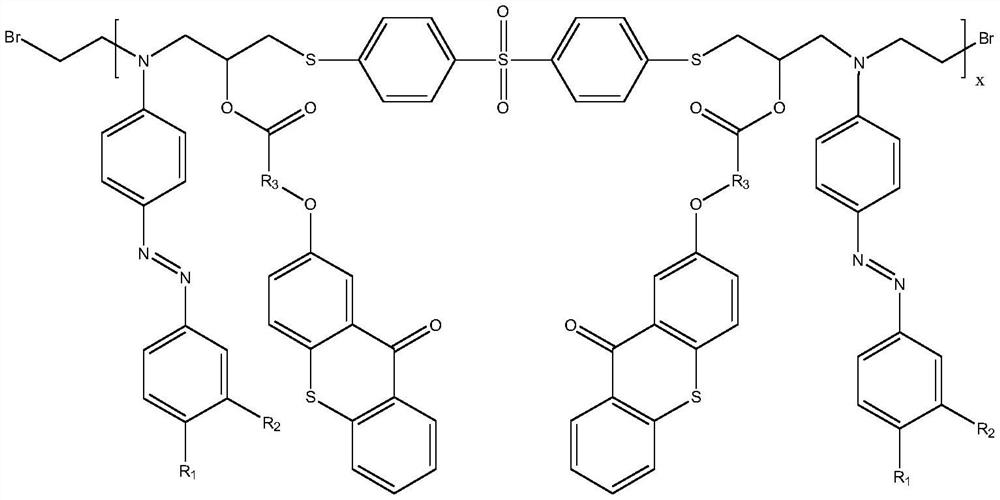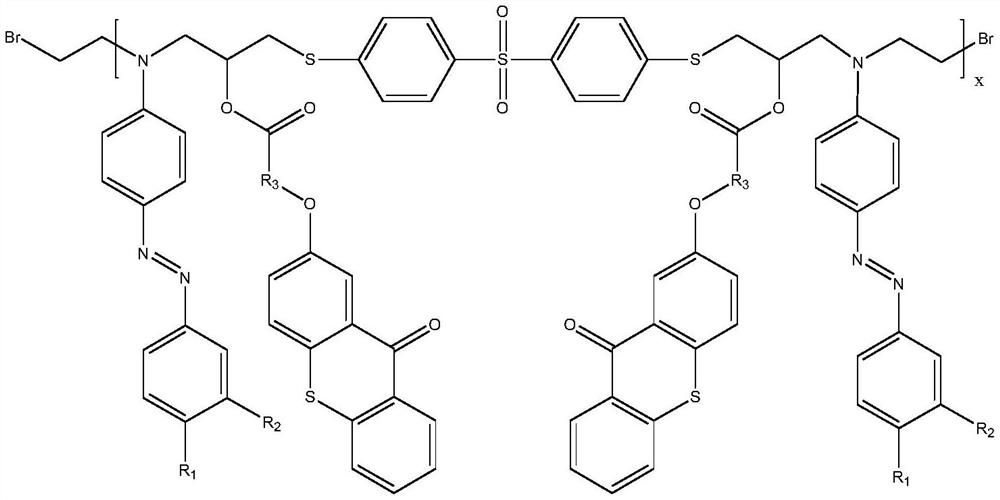Macromolecular anti-blue light additive and preparation method thereof
An anti-blue light and macromolecular technology, which is applied in the field of optical materials, can solve the problems of poor compatibility, easy migration and precipitation, etc., and achieve the effects of high initiation efficiency, improved blue light absorption efficiency, and favorable energy transfer
- Summary
- Abstract
- Description
- Claims
- Application Information
AI Technical Summary
Problems solved by technology
Method used
Image
Examples
Embodiment 1
[0040] A preparation method of macromolecular anti-blue light auxiliary agent, comprising the following steps:
[0041](1) The difunctional epoxy compound was dissolved in acetone and placed in a flask, 4-aminoazobenzene (-R 1 : -H, -R 2 :-H) is dissolved in N,N-dimethylformamide and placed in a constant pressure dropping funnel, dripping at a constant speed, after dropping within 1h, stirring at room temperature for 1.5h, after vacuum concentration, slowly add deionized water, stirring 30min, then add dichloromethane, stir for 30min, stand for stratification, take the organic phase and dry it with anhydrous sodium sulfate, then filter (filter out the crystalline hydrate of sodium sulfate), and rotate to steam to obtain intermediate product I;
[0042] The dosage ratio of the difunctional epoxy compound, acetone, 4-aminoazobenzene, N,N-dimethylformamide, deionized water, dichloromethane, and anhydrous sodium sulfate is 1mol:200mL:2.2mol : 300mL: 400mL: 300mL: 30g;
[0043] ...
Embodiment 2
[0052] A preparation method of macromolecular anti-blue light auxiliary agent, comprising the following steps:
[0053] (1) The difunctional epoxy compound was dissolved in acetone and placed in a flask, N,N-dimethyl-4,4'-azodiphenylamine (-R 1 :-N(CH 3 ) 2 , -R 2 :-H) was dissolved in N,N-dimethylformamide and placed in a constant pressure dropping funnel, dripped at a constant rate, after dropping within 1h, stirred at room temperature for 2h, and concentrated in vacuo; slowly added deionized water and stirred for 30min , then add dichloromethane, stir for 30min, stand for stratification, take the organic phase and dry it with anhydrous sodium sulfate, then filter (filter out the crystalline hydrate of sodium sulfate), and rotate to steam to obtain intermediate product I;
[0054] The difunctional epoxy compound, acetone, N,N-dimethyl-4,4'-azodiphenylamine, N,N-dimethylformamide, deionized water, dichloromethane, anhydrous sulfuric acid The dosage ratio of sodium is 1mol...
Embodiment 3
[0064] A preparation method of macromolecular anti-blue light auxiliary agent, comprising the following steps:
[0065] (1) The difunctional epoxy compound was dissolved in acetone and placed in a flask, 4-amino-3'-methylazobenzene (-R 1 : -H, -R 2 :-CH 3 ) was dissolved in N,N-dimethylformamide and placed in a constant pressure dropping funnel, dripped at a constant rate, after dropping within 1 h, stirred at room temperature for 1.5 h, and concentrated in vacuo; slowly added deionized water, stirred for 30 min, and then Dichloromethane was added, stirred for 30min, left to stand for stratification, and the organic phase was dried with anhydrous sodium sulfate, then filtered (the crystalline hydrate of sodium sulfate was filtered out), and rotary steamed to obtain intermediate product I;
[0066] The dosage ratio of the difunctional epoxy compound, acetone, 4-amino-3'-methylazobenzene, N,N-dimethylformamide, deionized water, dichloromethane, and anhydrous sodium sulfate is:...
PUM
 Login to View More
Login to View More Abstract
Description
Claims
Application Information
 Login to View More
Login to View More - R&D
- Intellectual Property
- Life Sciences
- Materials
- Tech Scout
- Unparalleled Data Quality
- Higher Quality Content
- 60% Fewer Hallucinations
Browse by: Latest US Patents, China's latest patents, Technical Efficacy Thesaurus, Application Domain, Technology Topic, Popular Technical Reports.
© 2025 PatSnap. All rights reserved.Legal|Privacy policy|Modern Slavery Act Transparency Statement|Sitemap|About US| Contact US: help@patsnap.com



